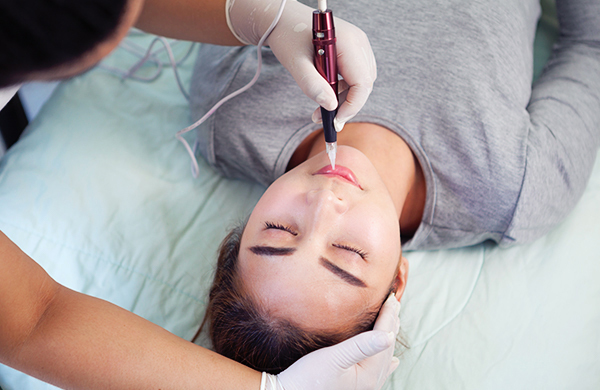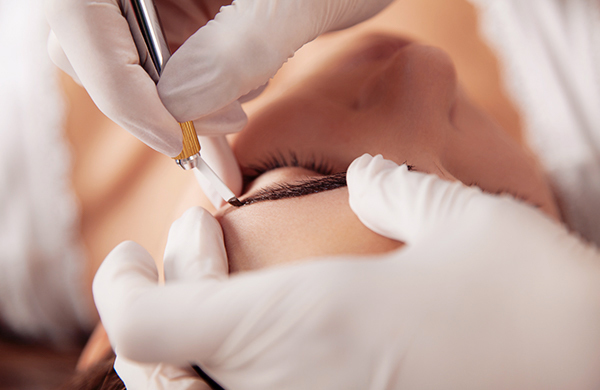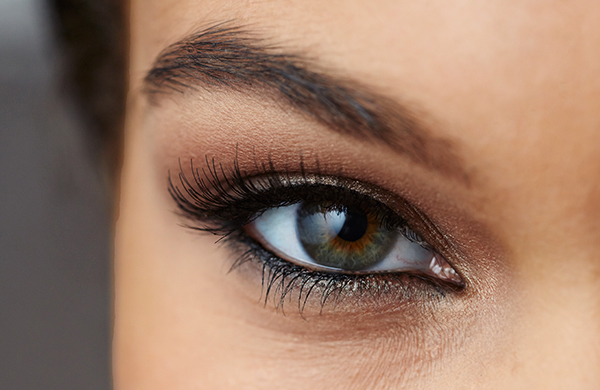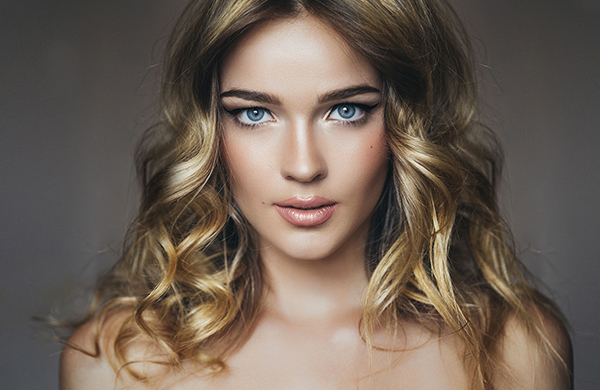
Permanent makeup can be a great option for those who wear cosmetics every day. But many of us don't know a lot of people who have it—or, rather, we don't realize when someone has it. That lack of widespread knowledge leaves the curious with a lot of questions about the makeup tattoos.
So we sat down for a chat with Maureen Donlan, owner of Chicago's Amazing Faces, who's been tattooing faces for more than a decade. We picked her brain on everything from how much does permanent makeup hurt to how long does it last. We even got her candid opinion on microblading (spoiler: it's not her favorite).
Permanent Eyebrows | Permanent Eyeliner | Permanent Lip Color | Is permanent makeup right for me? | Am I eligible for permanent makeup? | Does it hurt? | How long is an appointment? | How to Prepare | Posttreatment, Downtime & Touchups
Common Types of Permanent Cosmetics
Permanent Eyebrows

Right now, thanks to America's obsession with picture-perfect brows, this is probably the most popular cosmetic-tattoo request. There are three main types of permanent-eyebrow techniques:
Hair-stroke method: This is exactly what it sounds like, with lightly applied lines mimicking the appearance of natural hairs.
Microblading: This technique, also known as eyebrow embroidery and 3D brows, provides an even more natural appearance thanks to the use of tiny super-fine blades. The look is very natural, but take heed: Maureen said this method was too painful even for her to experience, and she has a high tolerance for pain. However, one customer who got microblading told us that she "felt a little discomfort, but no pain" after numbing gel was applied (click here to read her microblading story). So it varies from person to person.
Powder-fill brows: This technique involves thousands of tiny dots. Many choose to pair this method with one of the other techniques for an especially lush look. Some find that, on its own, a powder fill can look less natural due the resulting definition and opacity. Yet, this technique deposits ink more deeply than the other methods, which offers two advantages: powder-filled brows can go longer between touchups, and they'll last longer on older clients, whose skin generally loses pigment more easily.
Maureen, for her part, doesn't distinguish between methods, simply blending and customizing as necessary.
Permanent Eyeliner

Maureen recommends going for subtle over dramatic, perhaps getting just a thin swipe of ink on your upper lash line and only lining your lower lid if you regularly wear eyeliner there.
When our beauty editor got permanent liner, she found she needed only a little bit of mascara each day for her eye makeup to look done. For special events or trendier looks, she simply adds traditional eyeliner over the cosmetic tattoo for a thicker line or cat-eye flick.
Permanent Lip Color

Deciding to have permanent lip color means accepting that you have to go a bit darker than you may want. The lip color actually can take on a jarring red hue in the ink well—but it goes on more naturally and fades due to eating and talking. Maureen knows the brightness sometimes spooks skittish lip clients, but she doesn't mince words: "I will tell them right off the bat: if I go too light, you're just wasting your time and your money."
You also have to decide on the shape. Although many artists don't go past the natural border, Maureen goes just slightly beyond to make the lips look a bit fuller.
If you're going with lip color and also have a history of cold sores, your artist may advise you to start taking medication a few weeks beforehand. Permanent makeup can have glam results, but the process involves abrading the skin, which can encourage outbreaks.
"I will tell them right off the bat: if I go too light, you're just wasting your time and your money."
Is permanent makeup right for me?
You should consider it if:
- You simply like the look and enjoy the idea of spending less time getting ready.
- You have allergies or contact-lens sensitivities, which can limit the types of traditional makeup that can be worn.
- You are a bit older or have a medical condition that causes shaky hands, making daily application a hassle.
- You want to disguise over-plucked brows, alopecia, or scarring. Many permanent-makeup artists specialize in what's called medical tattooing, which helps camouflage certain conditions and restore the appearance of areolae for mastectomy patients.
You should avoid it if:
- You're a perfectionist. While Maureen goes for a natural look, she acknowledges the makeup has a particular appearance that clients should be prepared for. "Some people are just too picky to get permanent makeup," she says. "As soon as somebody says that they're a perfectionist, it's like, 'bye-bye.'"
- You aren't ready to commit. If you like constantly changing your makeup, you may want to avoid it.
- You have needle phobia. If the very glint of a needle scares you, you may want to stick to traditional cosmetics.
- You love trendy looks. Fads fade more quickly than ink does. No one is more of aware of this than Maureen. While bushy brows are in, she won't get past the natural brow border because "that's definitely going to be a look that changes." And when she's lining lids, she avoids cat eyes in case tastes change in the future. One woman came to Maureen looking to disguise a warped cat eye, which had risen too high due to an eye lift. It simply couldn't be done, so Maureen had to turn her away.
"As soon as somebody says that they're a perfectionist, it's like, 'bye-bye.'"
 Am I eligible for permanent makeup?
Am I eligible for permanent makeup?
Most people are eligible for permanent makeup. However, you may not be able to get permanent makeup if you have diabetes, blood-clotting disorders, or other diseases that interfere with your body's ability to heal. You also may not be able to get it if you are pregnant or breastfeeding, being treated for cancer, or recovering from open wounds or burns. And you should wait until any active acne in the area clears up.
A consultation with your doctor can help you determine if it's safe for you to get permanent makeup.
Will it hurt?
Unfortunately, yes. But how much depends on the area and the person. Again, Maureen thinks microblading is intense, while others say it's only a little uncomfortable. And lips are especially sensitive because they're so vascular. However, topical numbing solutions lessen the discomfort, and according to Maureen, "Most people do not take any painkillers." (If you do take painkillers, make sure it's not aspirin, which thins the blood.)
How long does an appointment take?
Maureen says to be prepared for at least two visits, for which she pencils in a solid two hours each. This includes the actual service, aftercare instructions, and consultation.
How to Prepare
Bring a picture
When you get a haircut, you pull up Pinterest on your phone or chisel a quick marble bust to show the stylist what you want. You should do the same for the permanent ink destined for your face so there aren't any miscommunications.
... and come to the consultation with your normal makeup on.
That gives the artist an idea of what you like. "I prefer them to draw in their eyebrows, so I can see what they want," Maureen says. Same goes with lip liner and eyeliner. Along with wearing it the day of, some self-portraits taken in a well-lit area can help show the artist what you like. Be very specific and very honest about what you're looking for.
And although the makeup artist will help you find your color during the consultation, it's good to have a handle on what colors work best beforehand. Then, the artist will custom-blend a color combo just for you.
Relax, just do it.
During the treatment, relax as best you can so the procedure can take place as smoothly and quickly as possible. "I don't mind if people bring their earbuds in," says Maureen, who lauds the quietness of her new machine as compared to the din of her old one. "The machines that I use are completely different from the machines that I started with," she explains, adding that they were much, much louder. The pigments are better, too. In olden times, they "would turn into browns or greens or blues," but today they stay at a stable brown or black.
Posttreatment, Downtime & Touchups
There will be swelling, and it may look "too dark."
Your skin might be swollen immediately afterward. Pigment will initially look darker than you expected, but it will soften over the first one to two weeks.
Prepare for itching—but no other real downtime drama.
Permanent makeup tends to have minimal or no downtime. In fact, after a half-hour rest, many eyeliner clients even drive themselves home. That said, the skin has been through a lot, so give it time. Brows and lips have a longer healing and scabbing time than eyeliner does.
Keep the area moist while it heals.
In general, you'll likely have to keep the area moist with a petroleum or antibiotic ointment. Try to avoid picking scabs, too, since premature flaking can cause patchy color dropout.
You will need touchups every 12–24 months.
Permanent-makeup ink is thicker than tattoo ink, which means it fades more quickly. Maureen's clients usually return for a touchup every 24 months, while other artists say the ink exfoliates out of the skin in about 12–18 months. The various types fade differently, too. Lip color, as we mentioned, fades faster due to all the talking, eating, and drinking we do on a daily basis. Your artist will help you design a touchup plan and might even discount future visits to keep your makeup looking fresh.










